OVULATION RATE, METABOLITE AND HORMONAL PROFILES OF EWES IN LOW BODY CONDITION STIMULATED WITH HIGH-ENERGY DIET DURING THE LATE-LUTEAL PHASE OF THE ESTROUS CYCLE
T. Moonmanee1*, S. Yammuen-Art1, S. Mekchay1 and C. Navanukraw2
1 Department of Animal and Aquatic Sciences, Faculty of Agriculture, Chiang Mai University, Chiang Mai, Thailand
2 Department of Animal Science, Faculty of Agriculture, Khon Kaen University, Khon Kaen, Thailand
*Corresponding author’s email: tossapol.m@cmu.ac.th
ABSTRACT
The aims of this study were to determine the effects of short-term feeding with a high-energy diet on the ovulatory capacity, metabolite, and hormonal profiles of ewes in low body condition score (BCS), and to investigate the relationship between these variables in the ovulated ewes. Sixteen ewes that had ovulated (day 0) after synchronized estrus were allotted into two experimental groups. The control group received a control diet (CD) throughout the experimental period, while the supplemental group was offered a high-energy diet (H-ED) for a 5-day period from days 10–14 after ovulation. The follicles were scanned by ultrasonography, and the blood was sampled to measure the metabolites and progesterone. On day 14, the number of large-sized follicles was greater in the H-ED than in the control ewes. On days 11, 13 and 14, the concentrations of glucose were found to be higher for the H-ED group compared to the CD group. Ovulation rate was greater in the H-ED than in the control ewes. Ovulation rate tended to be positively correlated with the number of ovulatory follicles. Thus, these data emphasize that use of a high-energy diet improves the glucose concentration, follicular growth, and subsequent ovulation rate in low-BCS ewes.
Key words: diet treatment, ewes, follicular population, glucose, ovulation rate.
|





